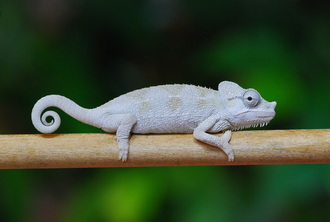Trioceros hoehnelii

Photo courtesy of Heather Lauren
Trioceros Hoehnelii, also known as the high casqued chameleon, is a medium sized montane chameleon averaging about 3-5 inches snout to vent. They are found in eastern Africa, primarily in Kenya and Uganda. Both the Kenyan and Ugandan types of this species have been kept and bred in captivity. Males are usually larger with a taller casque and a noticeable hemipenal bulge at the tail base. Females of this species are live bearing (viviparous), meaning they do not lay eggs instead produce live young.
Captive Care
The Basics
Ambient temps should be around 78F with a low wattage basking bulb (25-60 watts depending on where you live) provided as this species does like to bask. Night time temp drops during the summer of around 72F and high 50s to mid 60s during the winter are needed for this species. A good digital or infrared thermometer is a must have.
Housing
This species should be housed individually. Screen cages 18x18x36 work well as do glass terrariums 18x18x24. I prefer the glass terrarium fully planted. It is easier to maintain humidity in glass, but the temperatures need to be monitored more closely. A fish aquarium is NOT a reptile terrarium. It does not provide sufficient air flow and should not be used. Watering amount will depend on the type of enclosure you choose to use. With a screen enclosure, more frequent mistings or for longer periods are necessary. With glass enclosures water does not evaporate as quickly and 2 mistings per day for about 2 minutes each time should be sufficient. Temperature and water are very important to successful hoehnelii keeping.
Diet and Supplementation
Hoehnelii should be receiving the majority of their calcium and vitamins through their well gut loaded feeders. You should not rely solely on powdered supplements. Vitamins can be supplemented once per month. Calcium WITH D3 may be used once per week and calcium with OUT D3, every other week. Over supplementing may cause edema (fluid retention/swelling) in the animal. I have found this species to not be very picky eaters, though they do prefer flies. They did however show no interest in small sized worms such as silkworms and soldier fly larvae.
Article Written by Heather Lauren
Article Written by Heather Lauren
